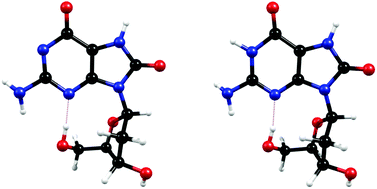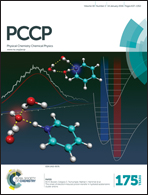Excited-state deactivation in 8-oxo-deoxyguanosine: comparison between anionic and neutral forms†
Abstract
8-Oxoguanine is the most abundant oxidation product found in oxidatively damaged DNA. The study of the excited-state properties of the corresponding deoxyribonucleoside 8-oxo-deoxyguanosine is thus of important biological relevance. Herein, we present an ADC(2)-s ab initio study of the neutral and the anionic form of 8-oxo-deoxyguanosine, for each of which we have considered the intramolecularly 5′-O–H⋯N3 hydrogen-bonded syn conformer. We present energy profiles for a radiationless deactivation mechanism via intramolecular excited-state proton transfer. This mechanism is accessible in the neutral form, but it is unavailable in the anion. We present optimized structures for the proton-transfer conical intersection of the neutral form as well as the ring-puckered conical intersections inherent to the 8-oxoguanine moiety for the neutral and anionic forms. We highlight the possible relevance of the proton-transfer mechanism for the neutral form and discuss our results in light of several recently published computational and spectroscopic studies. Our results provide new insight into the photophysics of this biologically relevant nucleoside and pave the way for future nonadiabatic dynamics studies and for further spectroscopic investigations.


 Please wait while we load your content...
Please wait while we load your content...